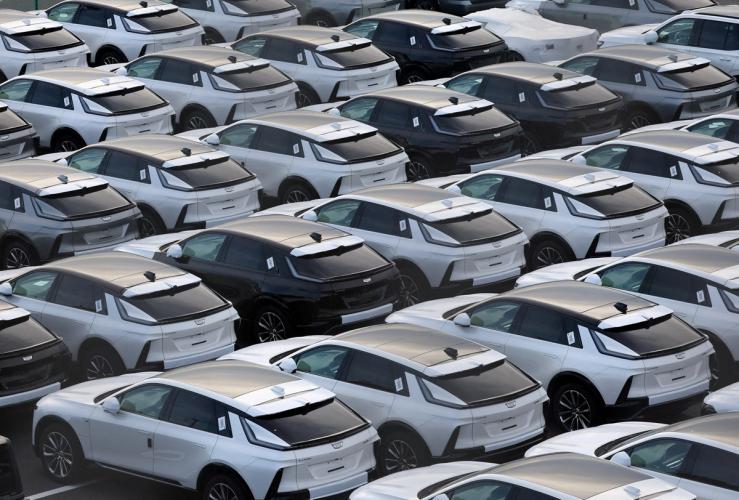The News
General Motors took a giant leap in autonomous driving Thursday when it announced a new capability that will allow drivers to take their eyes off the road on some US highways.
Several GM-produced cars today are equipped with Super Cruise, which allows drivers to keep their hands off the steering wheel on a large swath of US highways while remaining fully responsible for operating the vehicle. Super Cruise includes gaze-tracking technology that disables the system when drivers aren’t watching the road.
The new GM system, at Level 3 of the six-level scale of autonomy, will allow drivers to activate the system and look away, checking their email or making video calls, on roads where the car company can ensure it’s safe.
Robotaxis like those operated by Google’s Waymo do not require a driver behind the wheel, but are still considered Level 4 autonomy because they cannot travel outside designated areas that have been meticulously mapped and where the company can remotely operate the vehicles when the onboard computers slip up.
While GM isn’t the first car company to deploy Level 3 technology, it will likely offer the most extensive operating area of that kind of system to date, bringing the capability to a larger population of customers.
The move gives GM a leg-up over Tesla, which offers a “Full Self Driving” system that is able to navigate autonomously in any location, but still theoretically requires drivers to pay attention to the road at all times.
General Motors CEO Mary Barra and other executives at the Detroit automaker took swipes at Tesla Thursday, hailing GM’s use of lidar, a sensor that isn’t found on Tesla cars, and poking fun at CEO Elon Musk’s push to develop humanoid robots.
“We don’t need to replace the humans. What we need to do is make their job better, make it easier, make our product better and more efficient,” said Aamir Ali, GM’s associate head of product for advanced driver assistance systems, in a conversation with reporters.
In this article:
Reed’s view
Last year, I drove one of GM’s cars, a Cadillac Escalade, from San Francisco to Park City. The 766-mile drive was the perfect laboratory for Super Cruise. It not only made the drive less taxing, but shaved roughly a couple of hours off the total drive time by keeping a more consistent average speed.
I mentioned then that allowing drivers to take their eyes off the road would be a game-changer. Assuming it works, it is a major win for GM.
Even though I would rather drive GM’s new Escalade on a long road trip, it’s an unavoidable truth that Tesla’s “Full Self Driving” system is more advanced and may in the long run pull ahead of GM, and possibly even Waymo.
Early on in Musk’s robotaxi efforts, he claimed the company would have 1 million of them by 2020, a wildly ambitious timeline that is now much ridiculed. The path to Level 5 autonomous driving has turned out to be a much longer and bumpy one than the optimists once hoped.
Ironically, the stretched-out timeline could end up being an advantage for Tesla. Musk’s strategy from the beginning was to build an autonomous driving system powered by a neural network and cameras.
Waymo and other self-driving startups used a combination of cameras, lidar, and other sensors and built a complex network of fail-safes, detailed mapping, and human oversight.
The result of Waymo’s efforts is a robotaxi service that is a technological marvel, but one that requires human labor to expand it to new locations and maintain operations. The cars sometimes require remote operation when they encounter a situation that stumps the onboard computers.
Musk hasn’t achieved his goal of building a Level 5 car that can operate virtually anywhere, in any condition, without human intervention. But with recent advances in AI, it appears that he might have chosen the best path to that goal, even if his timeline was off.
It’s looking increasingly likely that lidar and other sensors are not necessary and that cameras may be the best sensors. And all those cameras on Teslas have amassed one of the largest, if not the largest, datasets for robotics today.
A Tesla equipped with the latest FSD is already safer than the average human driver. But that isn’t good enough. A single fatality would be politically unacceptable, and it’s unclear if or when we’ll get to that level of reliability.
The hope is that we are a handful of breakthroughs away from AI models that can leverage a massive dataset like Tesla’s while eliminating the unpredictability that makes today’s models impossible to deploy without human oversight.
Musk is betting his company on reaching that goal, which could enable Level 5 driverless cars, or robotaxis, and possibly even humanoid robots. Most CEOs would never take such a big risk because they would look foolish if they failed.
That obviously is not a concern for Musk. In some ways, the question has always been about the patience of the company’s investors. Will they stick around if there still isn’t a Level 5 car in five years? How long does the company really have to make good on its humanoid robot promise?
That’s an unanswerable question at the moment, but it is certainly a lot longer than Musk’s harshest critics.
Room for Disagreement
Elektrek argues that Tesla is on the wrong track with its technology. “Musk has been wrong about self-driving for years. His track record is marked by missed deadlines and broken promises,” it wrote after the recent robo taxi launch in Austin.
Notable
- Tesla’s “Full Self Driving” software is still highly prone to errors, so much so that it raises questions about whether it should even be legal, a Forbes analysis argues.
- Musk’s company is also struggling to get users to pay for the self-driving feature — only 12% are subscribed, and its third-quarter revenue declined in 2025 compared to a year earlier, Business Insider reports.


